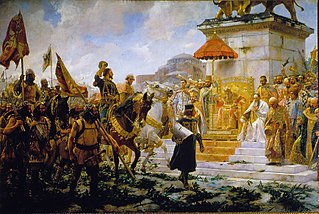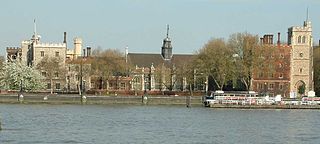
Pope Benedict XI, born Nicola Boccasini, was head of the Catholic Church and ruler of the Papal States from 22 October 1303 to his death, in 7 July 1304.

Pope Boniface VIII was the head of the Catholic Church and ruler of the Papal States from 24 December 1294 to his death, in 1303. The Caetani family was of baronial origin, with connections to the papacy. He succeeded Pope Celestine V, who had abdicated from the papal throne. Boniface spent his early career abroad in diplomatic roles.

Year 1297 (MCCXCVII) was a common year starting on Tuesday of the Julian calendar.

Year 1303 (MCCCIII) was a common year starting on Tuesday of the Julian calendar.

Year 1298 (MCCXCVIII) was a common year starting on Wednesday of the Julian calendar.

Boniface of Savoy was a medieval Bishop of Belley in Savoy and Archbishop of Canterbury in England. He was the son of Thomas, Count of Savoy and owed his initial ecclesiastical posts to his father. Other members of his family were also clergymen, and a brother succeeded his father as count. One niece Eleanor of Provence was married to King Henry III of England, and another was married to King Louis IX of France. It was Henry who secured Boniface's election as Archbishop, and throughout his tenure of that office, he spent much time on the continent. He clashed with his bishops, with his nephew-by-marriage, and with the papacy but managed to eliminate the archiepiscopal debt that he had inherited on taking office. During Simon de Montfort's struggle with King Henry, Boniface initially helped Montfort's cause but later supported the king. After his death in Savoy, his tomb became the object of a cult, and he was eventually beatified in 1839.
Clericis laicos was a papal bull issued on February 5, 1296 by Pope Boniface VIII in an attempt to prevent the secular states of Europe, in particular France and England, from appropriating church revenues without the express prior permission of the pope. The two expansionist monarchies had come to blows, and the precedents for taxation of the clergy for a "just war" if it was declared a crusade and authorized by the papacy had been well established. The position of Boniface was that prior authorization had always been required and that the clergy had not been taxed for purely secular and dynastic warfare.

Unam sanctam is a papal bull that was issued by Pope Boniface VIII on 18 November 1302. It laid down dogmatic propositions on the unity of the Catholic Church, the necessity of belonging to it for eternal salvation, the position of the Pope as supreme head of the Church and the duty thence arising of submission to the Pope in order to belong to the Church and thus to attain salvation. The Pope further emphasized the higher position of the spiritual in comparison with the secular order. The historian Brian Tierney calls it "probably the most famous" document on church and state in medieval Europe. The original document is lost, but a version of the text can be found in the registers of Boniface VIII in the Vatican Archives. The bull was the definitive statement of the late medieval theory of hierocracy, which argued for the temporal as well as spiritual supremacy of the pope.

William de Lamberton, sometimes modernized as William Lamberton, was Bishop of St Andrews from 1297 until his death. Lamberton is renowned for his influential role during the Scottish Wars of Independence. He campaigned for the national cause under William Wallace and later Robert the Bruce. As Bishop of St Andrews, the most powerful seat in Scotland, Bishop Lamberton along with Bishop Robert Wishart of Glasgow conducted the coronation of Robert the Bruce as King Robert I. Lamberton would go on to have a vital role in the formulation of the Declaration of the Clergy 1310 and the Declaration of Arbroath which would lead to Scottish Independence.
Giovanni Boccamazza was an Italian Cardinal. He was from the Roman nobility, and was a nephew of Cardinal Giacomo Savelli, who had been an important figure in the Roman Curia since his creation as cardinal in 1261.
Events from the 1290s in England.

Jean Lemoine, Jean Le Moine, Johannes Monachus was a French canon lawyer, Cardinal, bishop of Arras and papal legate. He served Boniface VIII as representative to Philip IV of France, and founded the Collège du Cardinal Lemoine, in Paris. He is the first canon lawyer to formulate the legal principle of the presumption of innocence.

Orvieto, Umbria, Italy, was the refuge of five popes during the 13th century: Urban IV (1261–1264), Gregory X (1271–1276), Martin IV (1281–1285), Nicholas IV (1288–1292) and Boniface VIII (1294–1303). During this time, the popes took up residence in the Papal Palace of Orvieto, which was adjacent to the Orvieto Cathedral and expanded onto the bishop's residence. None of these popes died in Orvieto, and thus no papal elections took place in there, nor are there any papal tombs.
Richard de Ferings, was the Archbishop of Dublin.
Bérard de Got was a French bishop and Roman Catholic Cardinal. He was the son of Bérard, Lord of Villandraut, and a brother of Bertrand de Got, who became Pope Clement V.
Simon de Beaulieu was a French bishop and Roman Catholic Cardinal. He was the son of Guy, Sieur de Beaulieu and of Agnes. Simon's brother, Jean, was Abbot of the Cistercian monastery of Notre Dame-de-Jouy in the diocese of Sens. Simon had another brother, Raoul, who was also buried (1286) at Jouy along with their mother.
Nicolas de Nonancourt. He was a French university Chancellor, Dean of a Cathedral, and Roman Catholic Cardinal.

Sir John de Kingston Lord of Kingston Bagpuize and Little Sutton was an English knight of the late 12th and early 13th centuries from Berkshire and Wiltshire. He fought in the wars in Wales, Flanders and Scotland. He was a signatory of the Baron's Letter to Pope Boniface VIII in 1301.

Luca Fieschi was a Genoese nobleman and Roman Catholic cardinal from 1300.
Events from the 1290s in Scotland.











